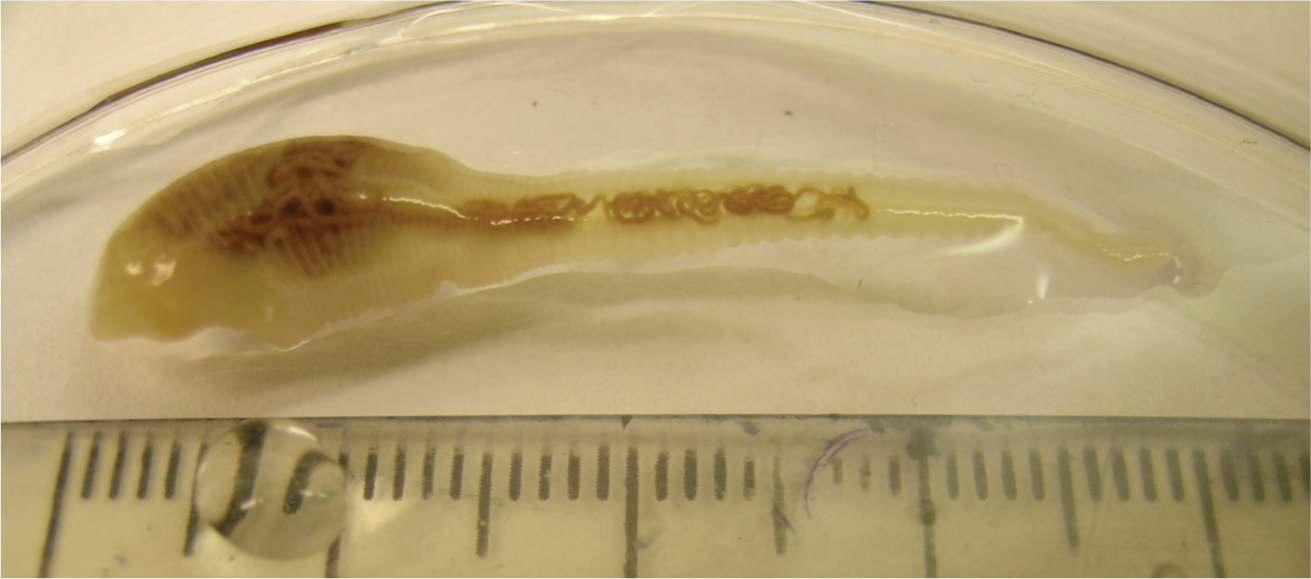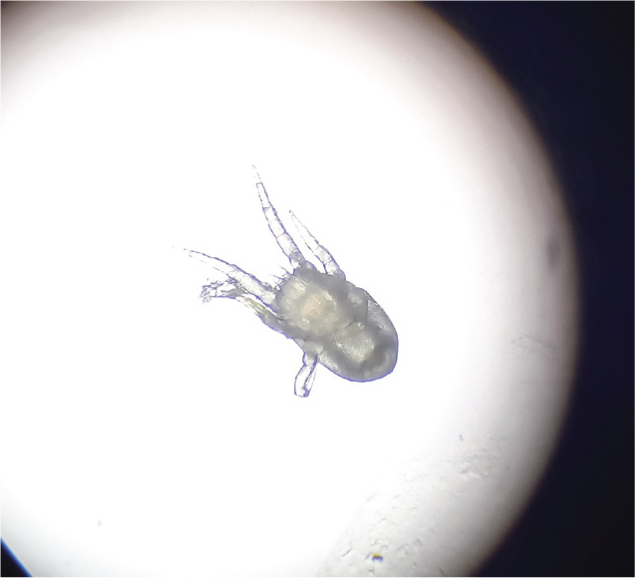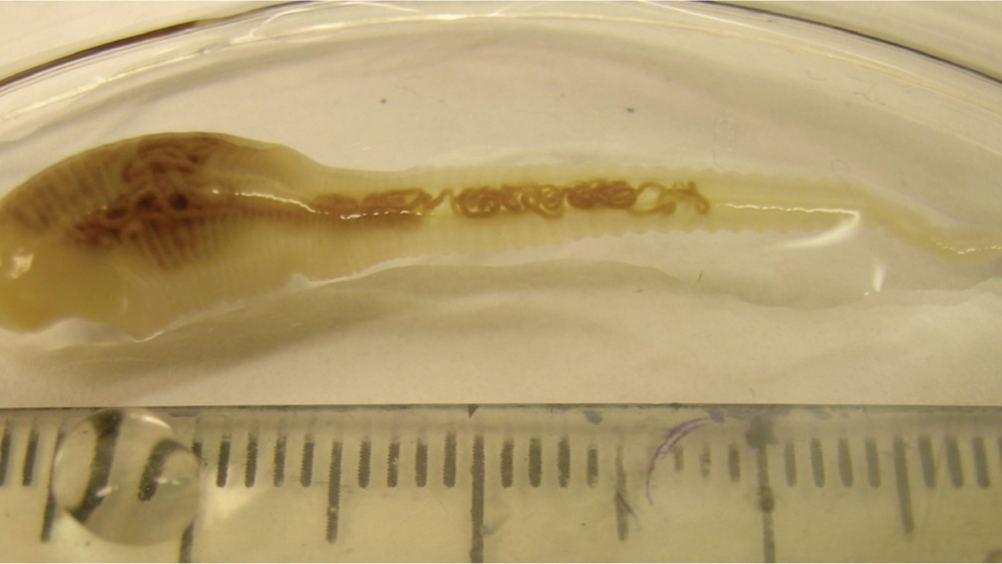The numbers of rescue dogs imported into the UK for rehoming remained high in 2021, providing ongoing potential for the introduction of exotic parasites into the UK (Figure 1).

Heartworm and Leishmania cases reported to ESCCAP UK & Ireland remained high, having been imported from a wide variety of countries both from inside Europe and more distant locations such as South America, Africa and Asia. A case of Thelazia callipaeda infection in a dog imported from Serbia was also highlighted (Silverwood, 2021a), reminding us that this parasite remains endemic in eastern Europe and is likely both under diagnosed and under reported.
Chief Veterinary Officer, Christine Middlemiss, also highlighted the zoonotic risk of Brucella canis entering the UK in imported dogs (Middlemiss, 2021). This risk extends to veterinary professionals coming into contact with infected dogs in practice, as well as new owners and charity workers. Vigilance for relevant clinical signs in practice is vital, alongside screening dogs imported from endemic countries, both to reduce personal risk but also to help prevent establishment of this pathogen in the UK.
While it is considered an exotic parasite, a rare case of Pneumonyssoides mites in an untraveled dog was recorded by the team at Brentknoll Vets, Worcester (Figure 2). The distribution of this mite is still poorly documented in the UK, but it can cause significant irritation. This case demonstrated that it should be considered as a differential diagnosis in any dog presenting with sneezing, nasal discharge or irritation.

In the summer of 2021, the government launched a consultation on proposed changes to pet travel and importation. The proposed rule changes included banning the importation of dogs with cropped ears and docked tails, as well as raising the minimum importation age to 6 months. These changes are likely to have a profound impact on the illegal puppy trade. While it supports these measures, ESCCAP UK & Ireland has also suggested that this is an opportunity to examine the rules regarding the testing of imported dogs for exotic pathogens, particularly those with zoonotic potential. In light of increased cases of Brucella canis in imported dogs, ESCCAP UK & Ireland called on the government to make testing for this pathogen compulsory in dogs imported from endemic countries. This would also be an opportunity to reintroduce compulsory tick treatment which, while only one of several measures required to prevent establishment of tick-borne pathogens, would help to slow this process.
UK household infestations with Rhipicephalus sanguineus, endemic foci of Babesia canis and tick-borne encephalitis virus in the south of England have demonstrated the importance of having an effective policy to prevent tick-borne pathogen establishment in the UK. The government might also consider compulsory testing for Dirofilaria immitis, Leishmania infantum and Ehrlichia canis, all of which can have a devastating impact on dogs' lives, months or years after their initial importation.
ESCCAP UK & Ireland continue to recommend veterinary surgeons follow four key steps (the ‘four pillars’) in all imported dogs. These are:
- Checking for and identifying ticks
- Treating dogs with praziquantel within 30 days of return to the UK, in addition to the compulsory treatment, and treating for ticks
- Recognising clinical signs relevant to diseases in the countries visited or country of origin
- Screening for Leishmania, heartworm and exotic tick-borne pathogens in imported dogs.
For dogs imported into the UK, ESCCAP UK & Ireland would recommend the following screening tests:
- Leishmania — quantitative serology and/or poymerase chain reaction (PCR)
- Heartworm — antigen blood test and a Knott's test.
- Ehrlichia canis and Anaplasma spp. — serology and PCR.
- Hepatozoon canis — blood smear and/or PCR
- Babesia spp — PCR
- Brucella canis — consult your external laboratory for suitable testing
- Leishmania and heartworm testing should be repeated 6 months later if initial tests are negative, or if relevant clinical signs develop.
A thorough clinical examination is also essential to identify relevant clinical signs and look for evidence of gross worm infestation, such as Thelazia callipaeda (eyeworm), Dirofilaria repens (skin worm) and Linguatula serrata (nasal pentastomid).
Toxocara
ESCCAP UK & Ireland continues to advise that all UK cats and dogs be treated at least every 3 months to reduce egg shedding. High risk groups (cats and dogs on raw unprocessed diets, those that hunt and those living with children or immunocompromised adults) should be treated monthly. A recent survey of UK pet owners suggest that worm treatment frequency in cats and dogs is much lower than this (Pennelegion et al, 2020).
Lungworm
Relatively mild weather in 2021 and into 2022 has likely supported continuing slug activity and numbers. Veterinary professionals should therefore continue to be vigilant for cases of Angiostrongylus vasorum in their area and advise preventative treatment for high risk dogs (previously infected dogs, those dogs living in close proximity to other cases, coprophagic dogs, those tending to eat slugs, snails, grass and amphibians).
ESCCAP UK & Ireland has continued to support a risk-based approach to prevention and keeping records of regional prevalence is key to this. Routine testing of dogs for A. vasorum, alongside those dogs with relevant clinical signs, enables practices to establish whether A. vasorum is present in their area, as well as demonstrating efficacy of control plans if dogs are already on preventative treatment.
Crenosoma vulpis is another lungworm endemic in the UK and should be considered as a differential in coughing dogs (Silverwood, 2021b). Risk factors for exposure are similar to those for A. vasorum, as are approaches to treatment and prevention.
Research has recently been published confirming the infectivity of L3 A. vasorum and C. vulpis larvae shed from gastropods (Robbins et al, 2021). While the significance of this route in field conditions is still unknown, this study demonstrates the potential for dogs to be infected from slime trails and water visited by slugs. As well as preventative treatment for dogs whose geographical location and lifestyle puts them at risk from exposure from A. vasorum, simple precautions such as bringing toys, food and water bowls indoors at night and avoiding walking after periods of rain, will also help to minimise any risk of transmission by this route.
Tapeworm
Welsh Government and Food Standards Agency offal condemnation figures demonstrate that the incidence of Echinococcus granulosus is much more widespread in Britain than previously thought. Post-mortem inspections in abattoirs across Britain have recorded positive cases, with a particularly high incidence on the Welsh border and in the north of the Midlands.
HyData UK is a 3-year multi-centre collaborative study investigating the national distribution of E. granulosus in high-risk dog populations (hunting hounds, farm dogs and pet dogs in rural areas), livestock (cattle, sheep) and horses at slaughter in England, Wales, Scotland and Northern Ireland. Using a molecular epidemiological approach and geographic information system methodology, the study is aiming to build a more comprehensive picture of the geographic distribution of E. granulosus in the UK. Until these results become available, prevention advice to pet owners must be based on the lifestyle risk of the pet, including:
- Monthly treatment with praziquantel of all dogs in known hydatid endemic areas, unless kept on leads and fed cooked diets
- Monthly treatment with praziquantel for any dogs outside these areas shedding Taenia tapeworm segments (the risk factors for Taenia and E. granulosus infection are broadly the same), fed raw offal or unprocessed raw diets, or those that have access to fallen livestock
- Quarterly praziquantel treatment for dogs in non-endemic areas that are out of sight and off the lead, with potential pasture access
- Promotion of anti-dog fouling, keeping dogs on leads around farms and livestock, and promotion of adequately frozen or cooked diets.
A presentation at the American Association of Veterinary Parasitology congress highlighted the importance of dogs with alveolar echinococcosis (caused by Echinococcus multilocularis) acting as sentinels for endemic foci. The parasite is now widespread in Canada, with evidence that it is establishing itself in the US as far south as Missouri. Infection was detected in domestic dogs acting as intermediate hosts before adult tapeworms were detected in the reservoir coyote population. Detection of alveolar cysts in the liver of domestic dogs could perform the same function here in the UK and should be considered as a differential diagnosis in cases of canine cystic liver masses.
Ticks
Tick-borne encephalitis virus has established in the UK (Holding et al, 2020), with a second human case of tick-borne encephalitis in the UK recently being reported (Public Health England, 2020).
While pets and their owners should continue to enjoy the beautiful New and Thetford forests, where there is evidence for establishment, the need for effective tick prevention has never been more important for those pets and people using the areas.
Tick prevention is also important in suspected B. canis endemic areas (Essex and its adjoining counties) and pets at high lifestyle risk (pets walking in tall grass or bracken, hunting cats, and dogs walking in pasture shared by livestock or deer). Checking for and removing ticks within 24 hours, and using an effective product that will rapidly kill or repel ticks, will greatly reduce the risk of tick-borne pathogen transmission.
Fleas
The Big Flea Project has found 28.1% of cats and 14.4% of dogs to be positive for fleas. Of these infested pets, 11.3% were found to be harbouring fleas infected with Bartonella and 5% with Rickettsia felis, both of which are zoonotic pathogens (Abdullah et al, 2019). They are of particular significance in the immune-suppressed, making flea control vital in these groups.
Veterinary professionals should continue to advise routine year-round preventative treatment for household flea infestations. As there is still no evidence of flea resistance causing flea control breakdown in the field, it is likely that compliance and owner education continues to play a significant role in flea control breakdown, so owner education and engagement remains key to successful control.
Research has reinforced the need to take environmental contamination with insecticides seriously (Perkins et al, 2021). Fipronil and imidacloprid contamination was found in UK waterways and it is possible that the source may have been flea prevention products. Further research is needed into all potential sources of waterway contamination including the veterinary industry. Year round flea treatment remains essential because:
- Exposure to fleas is ubiquitous
- Exposure occurs all year round and if treatment is delayed until flea infestations establish, then they take months to eliminate, resulting in increased morbidity and discomfort for pets and owners, as well as increased zoonotic pathogen exposure
- If veterinary professionals do not recommend year round flea treatment for cats and dogs then infestations will occur, leading to many pet owners seeking flea products elsewhere, often without correct application advice, leading to more environmental contamination.
In addition, shampooing and swimming should not take place after application and used packaging and unused products must be disposed of responsibly.
What is 2022 likely to hold?
One of the main focuses of 2022 is likely to be the responsible use of parasiticides. Late last year, the British Veterinary Association (2021), alongside the British Small Animal Association and the British Veterinary Zoological Society, produced a policy document on the subject outlining their position. In response to this policy position, ESCCAP UK & Ireland has made the following points:
- ESCCAP UK & Ireland supports the need for improved client education on the use of parasiticides, a risk-based approach and the need for more research.
- Year round flea treatment for all UK cats and dogs remains important to minimise the risks of UK household infestations. Cats and dogs are exposed year round and centrally heated homes will support flea infestations through the winter.
- If environmental contamination is occurring from parasite control products, then increased engagement with pet owners will reduce it, by avoiding products being washed off, misapplied or disposed of inappropriately.
- Human toxocarosis is unlikely to be avoided by good hand hygiene alone. Control of the parasite in cats and dogs is an essential component of toxocarosis control in humans.
- Tapeworm control in dogs at high lifestyle risk of exposure is essential to limit zoonotic risk.
- Anthelmintic resistance is not limited by not treating uninfected dogs. It would only be limited by allowing deliberate shedding of refugia into the environment. The zoonotic nature of some cat and dog helminths makes this path a difficult one for veterinary surgeons to take.
This debate is likely to continue throughout 2022. More research is required to establish parasite prevalence and distributions in the UK, as well the extent to which the UK is contaminated by pet parasiticide products. In the meantime, ESCCAP UK & Ireland will continue to promote the importance of keeping pets and the public safe from parasitic disease.


